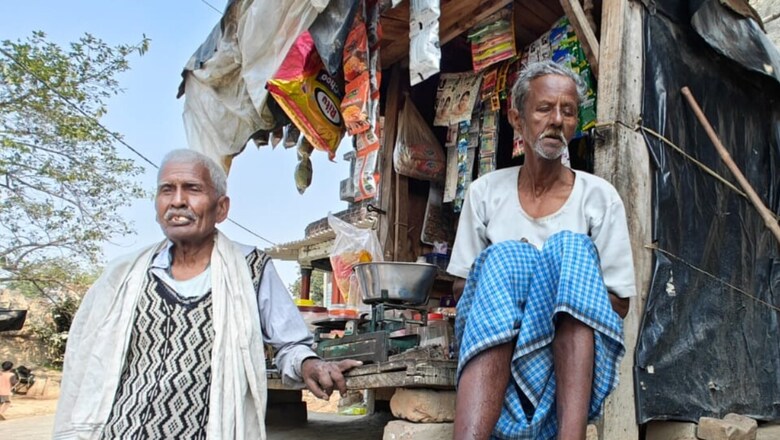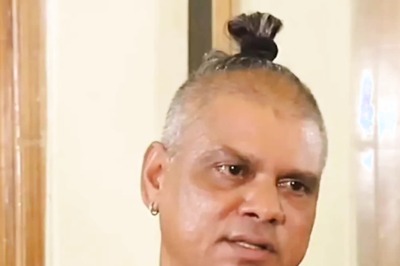
views
Visitors to 62-year-old Ram Ratan’s paan shop in a small hamlet named Virpur in Mall Block of UP’s Lucknow never return empty handed. Even when they don’t buy anything, Ram Ratan leaves with them a word of caution.
“I am a burden. I can’t walk or go out to earn money. My wound stinks. People don’t want me in social gatherings nor do they want to visit my place. I made the mistake of not taking the medicine on time and it made my life worse than hell. I request you not to commit the same mistake and lead a normal, healthy life.”
Ratan is a patient of Lymphatic Filariasis (LF), commonly known as elephantiasis because of the severe swelling and thickening of the skin it causes, particularly in the limbs.
“It’s a very painful disease, even worse than cancer and conveying a word of caution is just a small attempt on my part to create awareness among the people towards elephantiasis,” he says.
Elephantiasis or lymphatic filariasis is a parasitic disease caused by microscopic, thread-like worms. The condition is transmitted to humans through the bites of infected mosquitoes. These worms can block the lymphatic system over time, leading to swelling and thickening of the skin, particularly in limbs and genital areas. This results in the characteristic swelling and can cause disability, disfigurement, and social stigma.
In several cases, the person is infected in childhood, causing hidden damage to the lymphatic system. The painful and profoundly visible manifestations of the disease – lymphoedema, elephantiasis and scrotal swelling – occur later in life and can lead to permanent disability. The intricate network of vessels, organs, and specialized cells is profoundly impacted by filariasis infection, with symptoms often manifesting 10-15 years after contracting the infection. These patients are not only physically disabled, but suffer mental, social and financial losses contributing to stigma and poverty.
Treatment usually involves medication to kill the worms and manage symptoms, but advanced cases may require surgery or other interventions. Prevention focuses on controlling the mosquito population and avoiding mosquito bites in endemic areas.

Of the total numbers of blocks in Lucknow, Mall Block, where Ratan’s village is located, is infamous for the number of active cases of lymphatic filariasis.
‘It Was the First Time I Heard of Lymphatic Filariasis
Ram Ratan says he led a normal life until 2004. But one day, when his left leg began to swell up, he was diagnosed with elephantiasis. Ratan says this was the first time he had heard of the disease. But he made the mistake of not taking the medicines on time. Over days, his leg grew bigger and more deformed. Today, his bloated foot and thick skin resembles that of an elephant.
It’s been 20 years since Ratan was diagnosed and living with the deformed and bloated leg has not been easy. “Initially, I used to go out to work to meet the financial needs of my family. But this disease just made me immobile. I can’t walk or ride a bicycle to go out to work. It also adds to the social stigma. People don’t want to have me around. My wound stinks and I don’t have any option but to live with this disease that has made my life hell. This disease has traumatized me – mentally, physically and financially,” Ratan tells News18.
Ratan says the sole reason he is creating awareness among the people is doesn’t want anyone else to suffer his fate.
The Drive Against Lymphatic Filariasis
Officials with the health department say of the 2,500 people who live in Virpur Village, at least 12 are lymphatic filariasis victims. As per records, there are 558 active cases of lymphatic filariasis in Mall Block. In the neighbouring Malihabad Block, this number is believed to be 153, while Kakori has 217 active cases. Overall, Lucknow has 2,546 active cases of lymphatic filariasis, whereas Uttar Pradesh has around 1,46,022 such active cases.
Health department officials told News18 that under the National Health Mission, a gruelling drive has been launched across the Mall Block to eliminate lymphatic filariasis.
“We have undertaken the drive in the entire Mall block where the population is around 2 lakh. In the drive, we are covering all 67 villages which fall under Mall Block, with ASHA workers, Sanginis and auxiliary nurses are playing a crucial role. We have also roped in Gram Pradhans and some patients of elephantiasis in order to create awareness among the masses,” said Dr Sandeep Pratap Singh, Superintendent, Community Health Centre (CHC), Mall Block, Lucknow.

Singh, who is also part of the drive, said the team has been visiting each and every household and is administering drugs to all eligible individuals.
“We are visiting each and every house and administering doses to the people in the prescribed format. At the time of visits, we make sure that people consume medicines in front of us,” said Kanchan Lata Singh, an ASHA worker who has been tasked with carrying out an anti-filariasis drive in Ranipara village of Mall Block.
Suspicion and Superstition
According to Kanchan Lata Singh, administering the doses to people is not an easy task and the team has faced local rejection and opposition. “We are on the field and rejection and opposition are part of a drive. Many times people refuse to consume the medicine, saying there are no signs of illness. In such a situation, we have to make the person understand that even a normal or healthy-looking person can be a carrier of lymphatic filariasis.”
Sometimes the team is accompanied by an active patient to make the masses understand the severity of the disease once the infection sets in. “This is the most effective way to make the masses understand the importance of the medicine. Such volunteers are indeed of great help as they can make people understand the importance of the drug,” Kanchan Lata Singh says.
She adds that possible side-effects are another reason people don’t take the medicine. “There are instances when the patient suffers anxiety, vomiting, and headache soon after the medicine is administered. Such reactions often become a reason for refusal for others,” she adds.

Frontline workers say superstition is another roadblock. “Timely consumption of drugs is the only way to cure or avert this disease. But instead of consuming drugs, the patient often falls victim to superstition, which makes things worse. In one of the cases, the patient was asked to bury the leg in the ground for four days to cure elephantiasis. Similarly, another patient was asked by a quack to get the affected leg stung by a scorpion in order to cure the disease,” a frontline worker told News18.
Another myth says people who cross the land where an elephant had died are the ones who are infected. Another superstition says the disease is payback for sins of a past life.
Target of Filariasis-Free UP by 2026
In a dedicated push to eliminate filariasis from the region, the Yogi Adityanath government has initiated the door-to-door administration of anti-filarial medications across several districts as part of the Mass Drug Administration (MDA) campaign, starting February 10, 2024. In line with the directives of Chief Minister Yogi Adityanath, this initiative aims to reach every household in the state in the battle against the debilitating disease.
Within the first four days of the door-to-door campaign, around 20% people took the medicine. The campaign will run until February 28. The UP CM has urged the healthcare teams not to just distribute the medication, but also to educate the populace, emphasizing the importance of awareness in achieving the campaign’s goals.
The government has set an ambitious target to eliminate filariasis from the state by 2026, aligning with the central government’s goal to achieve nationwide elimination by 2027. Globally, the target for eliminating this disease has been set for 2030.
Officials with the health department said communities in areas such as Amethi, Azamgarh, Ballia, and Barabanki have displayed keen interest in learning about the potential side effects of the medication. They inquire about issues such as headaches, dizziness, and the medication’s efficacy on an empty stomach.
However, the health teams are assuring the populace that the anti-filarial medication is entirely safe, despite occasional side-effects like headache, body pain, fever, vomiting, rashes, and itching, which typically subside on their own.
In other areas like Lucknow, Unnao, Shahjahanpur, Bareilly, and Hamirpur, initial hesitancy towards taking the medication has been observed among some individuals. However, after receiving information from the health teams, many have willingly come forward to receive the treatment.
Dr Ramesh Singh Thakur, the state program officer for filariasis, revealed that the campaign aims to administer the medication to a total of 3,60,25,891 individuals. Impressively, within just four days, approximately 66.14 lakh people, constituting around 20% of the target population, have received the anti-filarial medicine.
Currently, there are 51 districts in the state grappling with filariasis. The ongoing campaign is operational in 17 of these districts.
Other than UP where there are more than 1,46,022 active cases of filariasis, the official record suggests that at the national level 680 million Indians are currently at risk of contracting the disease. The infection has been reported in 328 districts across 20 states and Union Territories.
Till 2021, 5.27 lakh cases of lymphoedema and 1.78 lakh cases of hydrocele were reported from endemic districts. About 90% of the filariasis burden in the country is contributed by eight states – Uttar Pradesh, Bihar, Jharkhand, West Bengal, Chhattisgarh, Maharashtra, Odisha and Madhya Pradesh.




















Comments
0 comment